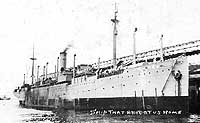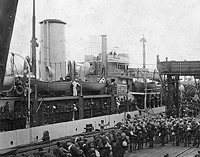
U.S. NAVY TEMPORARY AUXILIARY SHIPS, 1917-1919
WORLD WAR I ERA TRANSPORTS --
Converted Freighters of Miscellaneous Types
Sixteen U.S. Navy's WWI era converted freighters transports were of notably different design than those listed on other pages, or cannot be typed on the basis of dimensions and photographs. Similar characteristics link one sub-grouping of three ships and another three subgroups containing one pair each. The remaining eight, among them five ex-German vessels, were apparently all "singletons".
Ten of the sixteen had initial Navy service as cargo ships before being converted to transports between late 1918 and the spring of 1919. The other seven were acquired following the end of fighting and only served in the transport role.
This page features a table (with links to individual ships) of World War I era U.S. Navy transports converted from freighters of miscellaneous types, plus a photograph of each ship in this group.
Click the small photographs to prompt a larger view of the same image with a descriptive header.
Ships in this group:
SIXTEEN SHIPS, of varying appearance and characteristics. mast, kingposts and smokestack arrangement, as well as deck line configuration and other details, are useful for identifying individual ships and sub-groupings. These vessels are listed below in order of length:
One ship, built by the Maryland Steel Company at Sparrows
Point, Maryland, in 1903.
Built as S.S. Maine. Later acquired by the American-Hawaiian Steamship Company and renamed. Midships
superstructure extends to the hull sides. Served as cargo ship and then as transport.
Arrangement of kingposts, masts and smokestacks (funnels): M-M-F-M-M:
One ship, built by Bremer-Vulcan shipyard, Vegesack, Germany in 1913.
Coding for this ship's arrangement is unusually complex, as her topsides are cluttered with a "forest"
of tall kingposts, all also used as ventilators. USS Rappahannock (AF-6) was a near sister.
Arrangement of kingposts, masts and smokestacks (funnels): K-M-K-KF-K-K-M-KS:
One ship, built by the Neptun shipyard at Rostock,
Germany in 1912.
Split superstructure. Forward pair of kingposts are incorporated in the superstructure face.
Arrangement of kingposts, masts and smokestacks (funnels): M-K-KF-M-K
Two ships, built by the Sun Shipbuilding Company at Chester, Pennsylvania, in 1918.
These ships had flush-deck hulls, and a split midships superstructure. While in USN service, their port midships
kingposts were extended to form a signal mast with the topmasts being shortened or omitted). Both served as cargo ships and then as transports.
Arrangement of kingposts, masts and smokestacks (funnels): M-KF-M:
One ship, built by Blohm and Voss at Hamburg, Germany in 1907.
This ship had a very long combined poop and midships island, separated by a short well from her raised forecastle.
Arrangement of kingposts, masts and smokestacks (funnels): M-K-F-M:
One ship, built by the Newport News Shipbuilding and Dry Dock Company at Newport News, Virginia, in 1916.
This ship had a flush main deck, with low bulwarks at the bow and amidships,
plus four tall masts. She served as a cargo ship and then as a transport.
Arrangement of kingposts, masts and smokestacks (funnels): M-M-F-M-M:
Three ships, built by the Union Iron Works/Bethlehem Steel Company at San Francisco, California, in 1917-1918.
These ships had a split superstructure amidships. All three served as cargo ships and then as transports. Notes:
(1) As completed Liberator's masts were of kingpost height,
but were raised by 1919, when she served as a transport. A light
signal mast was fitted aft of her smokestack, which was shorter
and thinner than in Tiger and Peerless.
(2) In USN service (but not when completed), Tiger had
a light mast atop her pilothouse.
(3) Both Tiger and Peerless had a large letter "S"
on each side of her smokestack.
Arrangement of kingposts, masts and smokestacks (funnels): M-KF-M (see Notes (1) and (2) above):
Two ships, built by the Newport News Shipbuilding and Dry Dock Company at Newport News, Virginia.
As completed El Oriente appears to have also had a pair of kingposts just forward of the superstructure
face. Both served as cargo ships and then as transports.
Arrangement of kingposts, masts and smokestacks (funnels): M-F-M:
Note: USS El Occidente had identical tonnage and dimensions to El Oriente and El Sol. Also built by the Newport News Shipbuilding and Dry Dock Company in 1910, she served as a Navy cargo ship in 1918-1919, but was not employed as a transport.
Two ships, built by the Cramp Shipyard at Philadelphia,
Pennsylvania in 1913 for operation by the W.R. Grace Steamship
Company.
The dimensions of Santa Clara and Santa Cecilia were identical
to those of five other W.R. Grace ships presented in another
page of this presentation, but had flush deck hulls with low
bulwarks at the bow and amidships, and no kingposts. Santa
Clara served as a cargo ship and then as a transport. A third sister,
Santa Catalina, became the destroyer tender USS Black Hawk (AD-9).
Arrangement of kingposts, masts and smokestacks (funnels): M-F-M:
One ship, built by the Union Iron Works, San Francisco, California, 1916.
This ship had a very long midships island, with her masts located near its ends. Relatively short wells separated
her island from the forecastle and poop. Served as a cargo ship and then as a transport.
Arrangement of kingposts, masts and smokestacks (funnels): M-K-F-M:
One ship, built by Bremer-Vulcan shipyard, Vegesack,
Germany in 1912.
Arrangement of kingposts, masts and smokestacks (funnels): M-F-M














